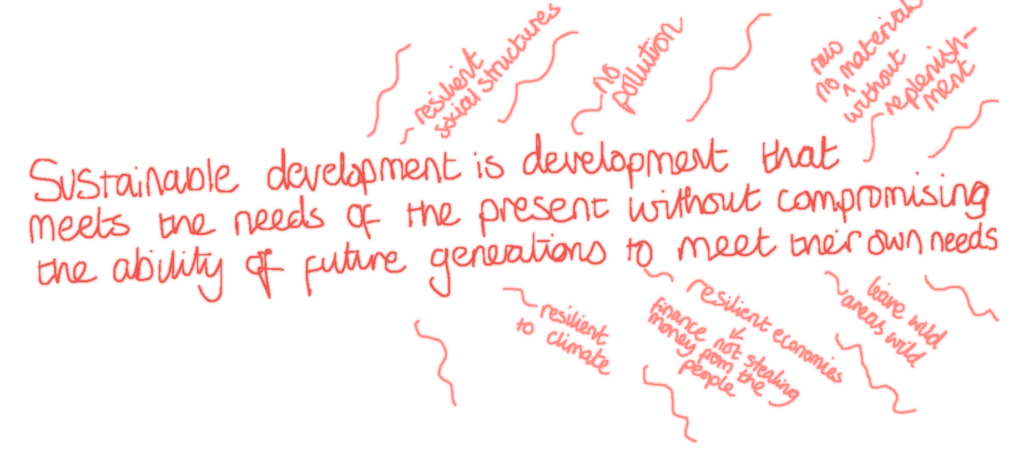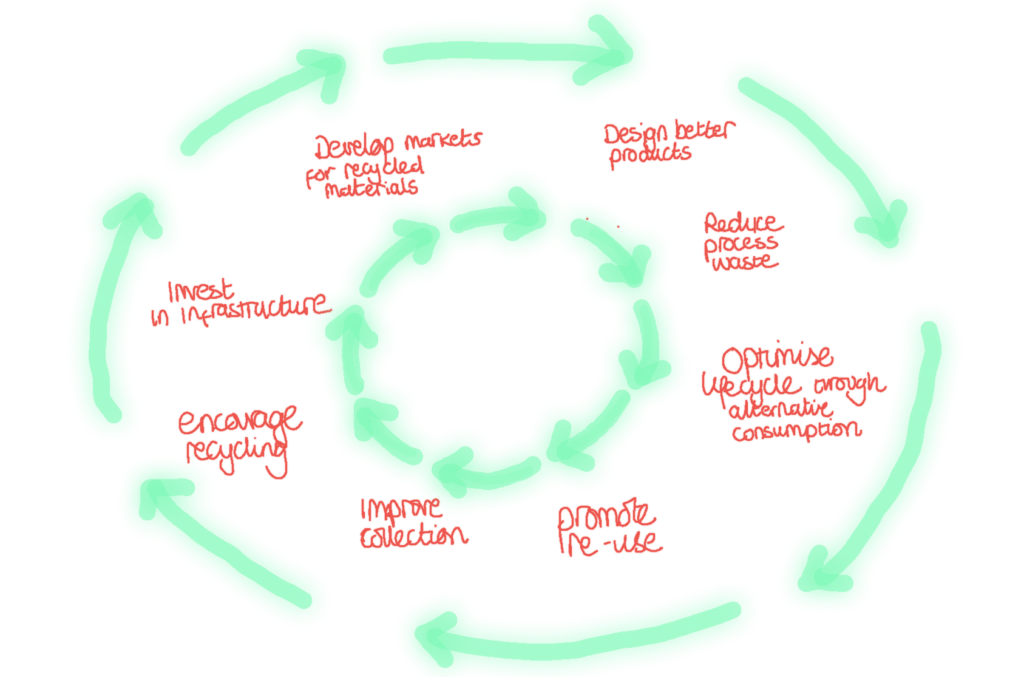In this post, we discuss why there are problems with our current economic system. We’ll answer the questions: what is sustainable economics? And, what are the key principles of sustainable economics?
Economic growth
The modern economy is based on economic growth. We tend to think of a growing economy as good for humanity: It means wealth, employment, money flowing between people and services, investment and all things that make economists happy.
Only, the idea of consistent growth forever is strange. Most natural thing’s don’t grow forever; they grow until they’re mature, and then they stop growing. We now are starting to have reason to question the assumption that we need growth for flourishing economies. We can now ask: is growth is a good thing at all? If we still want a high level of production, employment and wealth, there are other ways to do that.
Why are there limits to sustainable growth?
Growth is ok while there is an abundance of nature, etc., but the costs of growth become more noticeable when economies grow too big, too fast. These ‘costs’ are the destruction of the environment from mining, burning materials and producing greenhouse gas emissions. From releasing highly acidic compounds into seas and oceans, damaging sea life. The true cost of economic development is much more complicated than current economic systems account for.
Just like when anything grows, it takes something in and uses that resource to make itself bigger. It’s food for humans; for plants, it’s sunlight and water. For the economy, it’s natural resources. It’s either unsustainable raw materials or un-sustainably cheap labour.
We can expect growth in economies that are in the early stages of developing. It provides jobs, money for public services like hospitals and schools. It allows investment and businesses to start up and create even more employment.
But then, in the lifecycle of the global economy, once all the material goods have been set in motion producing and working, the most lucrative space to move economic activity into is the finance sector. Suddenly, in finance, there are opportunities to make money that are five times as big. The finance sector does not add to the economy; it sucks money from the economy. While the economy might be growing, but money is not circulating or creating economic opportunity amongst the people. It’s syphoned towards those at the top of the wealth ladder, becoming useless to most people who contribute to the economy through real jobs.
What is sustainable economics?
What is sustainable economics? Sustainable economics is a way to keep the good bits of economic growth and prosperity but in a way that will continuously allow the needs of future generations to be met.
When we talk about sustainable economics, people get two slightly different impressions of what that means. Some think of an economy set to keep growing steadily and constantly. Some believe that sustainable economics is a well-functioning economy that pays attention to the needs of the environment and society. The two are interlinked, and both need to be true for a sustainable economy (or sustainable economic growth).
What does sustainable economics mean?
When you google sustainable economics, the following sites come up first:
- The EU wwf say “A sustainable economy is one that is resilient and provides a good quality of life for everybody”
- A definition offered on the University of Mary Washington page says “Economic sustainability refers to practices that support long-term economic growth without negatively impacting social, environmental, and cultural aspects of the community.”
- Britannica say “Sustainable development is an approach to economic planning that attempts to foster economic growth while preserving the quality of the environment for future generations. “
- Twink.org say “The general definition of economic sustainability is the ability of an economy to support a defined level of economic production indefinitely.”
The most common definition for sustainability comes from the Brundtland Commissions in 1987 and goes:
“Sustainable development is development that meets the needs of the present without compromising the ability of future generations to meet their own needs”

(annotate this section with lines and then- things like – no pollution, no more raw materials without replenishment. Annotate resilient with – not susceptible to finance people hacking your economies, annotate
What are some key principles of sustainable economics?
This next section will cover 3 key principles of sustainable economics. They are three of the biggest ideas in the field of sustainable development, today. These are:
- Doughnut economics
- The three pillars of sustainability
- The circular economy
I will explore each in turn below to see what they cover.
Doughnut economics
This principle comes from a very famous book published by Kate Raworth.
The principle is this: there are certain social standards what we need to maintain for humanity. These have been discussed and set by the United nations, for example, in their sustainable development goals. They include: food, housing, healthcare, social justice, equity, education, water energy, income and work and justice.
We need a steady state of economic flow to have these things in place. The inside ring of the doughnut depicts this point. But, beyond a certain point, achieving these things pushes the planet’s boundaries and leads to global warming, climate change, air pollution and environmental destruction. Chemical pollution leads to ozone depletion and ocean acidification. Land-use change can lead to mass biodiversity loss as, can all of the factors above. This upper limit is the ‘ecological ceiling’ and is depicted by the outside ring of the doughnut.
The theory says there is a small balance point where we need to take our economics, to give everything we need and not overuse or exhaust. In terms of what this means practically for our economy, there is a great resource here in the doughnut economics action lab.

The three pillars of sustainability
The three pillars of sustainability: economic, environmental and social, is sustainable economics framework that is becoming very common in the corporate world.
The idea behind the three pillars is that each aspect needs to be considered when making a sustainable change. In business, a more commonly used version is the ESG metric, the Ethical Social and strong Governance principle.
Companies can get credit for certain measures that improve the ethical stance of the company. This example from nerd wallet, shows some of the aspects that corporations must have inline to achieve the rating.
Investment into ESG funds has taken off in recent years. Rather than investing in index funds that track the best performing stock indexes, regular people with little experience can invest in ESG indexes. As a result, their money only goes to companies with this framework.
It’s a significant step, but it’s criticised as a token and part of the greenwashing narrative of many big companies and their practices. There are improvements to the criteria that can be made, but to the best of my knowledge, it’s the first super easy way for us as citizens to invest in ‘good’ companies without needing to know the ins and outs of how each company works. Our economic vote in the financial market is like political voting in elections.
Whether or not the companies that get this rating are perfect, it’s a push in the right direction- and the next step will be tighter definitions and more transparent clear-cut rankings.
The Circular Economy
Another massive idea in sustainable economics is that of a circular economy. This refers mainly to things; and says that
Our strong economies thrive off linear economics because it gives high profits to manufacturers and cheap prices to the consumers in high-income countries. But, the linear economy doesn’t account for the enormous environmental costs of the activity it produces, like chemicals, pollution, greenhouse gas emission and waste. Linear economies have typically functioned well because the workers in lower-income countries will work for less money. That benefits those in higher-income countries. So it’s not socially very sustainable because lower-income workers can be easily exploited by poor fairness standards. In other words, the economic pillar does well in linear economics, but the social and environmental pillars do not.
The idea of the circular economy is to maximise the lifetime of all the components we have. It would do this by reusing and recycling them fully. The difference between the circular economy principle and regular household recycling is that in household recycling, products degrade with each re-cycle. There’s comes a point where they can’t usefully be recycled further. The circular economy principle proposes that everything be designed to be easily taken apart and reassembled, including the copper in the wires in your toaster, and the chemicals in the batteries of your phone.

By doing this there will be way less extraction and industrial processing of raw materials. There will however be a lot of work in redesigning re-assembling and fixing. As these new job opportunities emerge, it will have a big impact on global employment.
Conclusions- what is Sustainable Economics?
This post looked at what sustainable economics means and three key principles around the topic of sustainable economics. These principles were the economic donut, the three pillars of sustainability and the circular economy. Sustainable economics is a way we can live our lives but still value our world and it’s natural resources. It will allow for new companies and industry in developing countries, where sustainable business is established from the onset. We still want high life standards and income per capita, but there are ways to do that alongside the sustainability goals.
